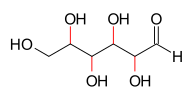Quy tắc Le Bel–Van 't Hoff
Giao diện

Trong hóa hữu cơ, quy tắc Le Bel–Van 't Hoff phát biểu rằng số đồng phân lập thể của một hợp chất hữu cơ không chứa mặt phẳng đối xứng là 2n, trong đó n là số nguyên tử carbon bất đối. Joseph Achille Le Bel[1] và Jacobus Henricus van 't Hoff[2] đều công bố lý thuyết này vào năm 1874 và điều này giải thích cho tất cả sự bất đối xứng phân tử được biết vào thời điểm đó.[3]
Ví dụ, bốn trong số các nguyên tử carbon của phân tử aldohexose là bất đối xứng, do đó quy tắc Le Bel–Van 't Hoff đưa ra phép tính 24 = 16 đồng phân lập thể. Trong các đồng phân lập thể này bao gồm tám đồng phân phi đối hình (diastereomers) khác nhau: allose, altrose, glucose, mannose, gulose, idose, galactose và talose.
Tham khảo
[sửa | sửa mã nguồn]- ^ Le Bel, Joseph Achille (1874). “Sur les relations qui existent entre les formules atomiques des corps organiques et le pouvoir rotatoire de leurs dissolutions” [On the relations that exist between the atomic formulas of organic substances and the rotatory power of their solutions]. Bulletin de la Société Chimique de Paris (bằng tiếng Pháp). 22: 337–347.
- ^ Van 't Hoff, Jacobus Henricus (1874). “Sur les formules de structure dans l'espace” [On structural formulas in space]. Archives Néerlandaises des Sciences Exactes et Naturelles (bằng tiếng Pháp). 9: 445–454.
- ^ “Le Bel–van 't Hoff rule”. TheFreeDictionary's Medical dictionary.
